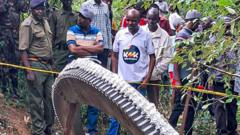The asteroid 2024 YR4, identified through observations from the Magdalena Ridge 2.4-meter telescope, has become a focal point for astronomers. Detected in December, this sizable space rock, measuring between 130 to 300 feet long, is on a trajectory that could bring it very close to Earth in 2032. Currently, the calculated odds of it colliding with our planet on December 22, 2032, stand at approximately 3.1 percent, marking it as the most significant impending threat compared to earlier concerns surrounding Apophis, which had an estimated impact probability of 2.7 percent when discovered in 2004. After closer observation, the chances of Apophis striking Earth were deemed negligible.
While the scale of 2024 YR4 is relatively small compared to Apophis, any asteroid of its kind is still capable of considerable destruction. The impact's severity largely hinges on the event’s atmospheric entry location. A direct hit on a metropolitan area could inflict considerable damage, although a significant portion of its potential trajectory passes over uninhabited oceans. Notably, potential impact sites are alarmingly close to populous cities such as Bogotá, Lagos, and Mumbai.
Astronomers have yet to determine the exact mass or density of 2024 YR4 due to a limited observational dataset. This uncertainty complicates predictions concerning its potential kinetic energy and destructiveness in the event of a collision. Mark Boslough, a physicist at the Los Alamos National Laboratory, emphasized this uncertainty regarding the asteroid's properties, stating that further studies are crucial for understanding the possible outcomes of its future close encounter with Earth.
While the scale of 2024 YR4 is relatively small compared to Apophis, any asteroid of its kind is still capable of considerable destruction. The impact's severity largely hinges on the event’s atmospheric entry location. A direct hit on a metropolitan area could inflict considerable damage, although a significant portion of its potential trajectory passes over uninhabited oceans. Notably, potential impact sites are alarmingly close to populous cities such as Bogotá, Lagos, and Mumbai.
Astronomers have yet to determine the exact mass or density of 2024 YR4 due to a limited observational dataset. This uncertainty complicates predictions concerning its potential kinetic energy and destructiveness in the event of a collision. Mark Boslough, a physicist at the Los Alamos National Laboratory, emphasized this uncertainty regarding the asteroid's properties, stating that further studies are crucial for understanding the possible outcomes of its future close encounter with Earth.















